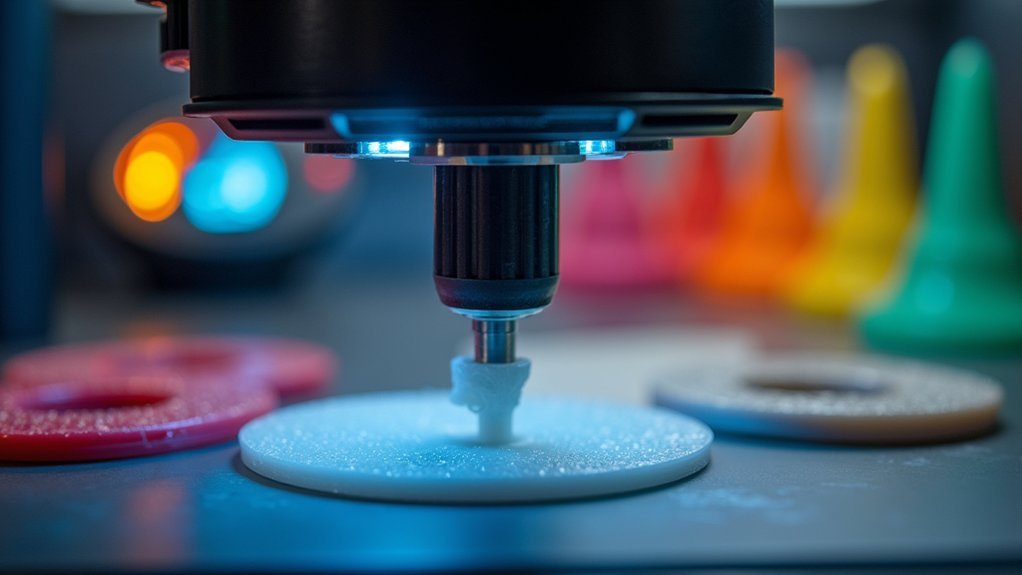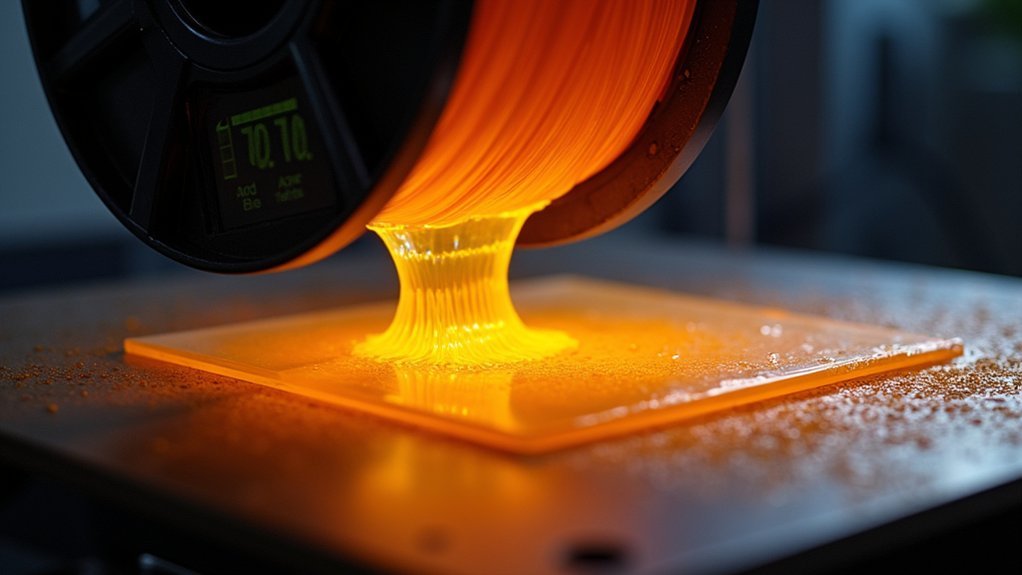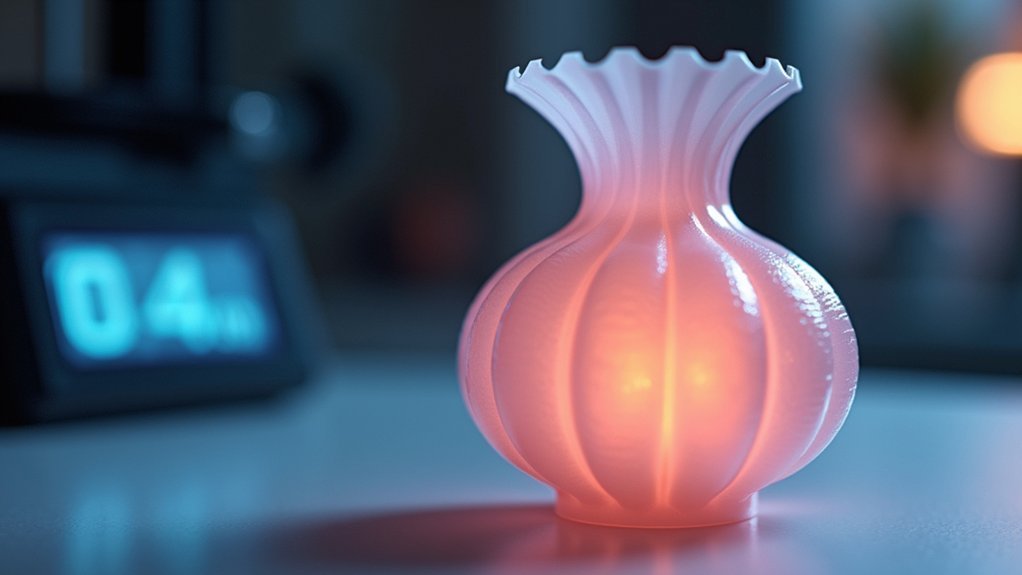You’ll need to set your PETG nozzle temperature between 220-260°C, with 230°C ideal for first layers and detailed prints. Keep your heated bed at 80°C baseline, adjustable between 70-90°C depending on surface type. Start with slower speeds at 10mm/s for initial layers, then coordinate temperature increases with speed reductions. Adjust retraction settings from 2-6mm based on your temperature choice and drive system. These foundational settings will transform your printing success when properly fine-tuned together.
Optimal Nozzle Temperature Range for PETG Filament

When you’re setting up your PETG print, the nozzle temperature becomes your most critical variable for success.
You’ll want to work within the 220°C to 260°C range, though the exact sweet spot depends on your specific filament brand and printer model.
Start with lower temperatures around 220-230°C for smaller prints or detailed work. For larger, complex prints, you’ll likely need higher temperatures up to 260°C to guarantee proper layer bonding.
Start at 220-230°C for detailed prints, then increase up to 260°C for larger projects requiring stronger layer adhesion.
Make adjustments in 5°C increments to fine-tune your results.
Consider starting your first layer at 230°C for better bed adhesion, then increase to 240°C or higher for subsequent layers.
Remember that temperatures below 220°C cause weak layer adhesion, while exceeding 260°C increases stringing and oozing risks. Achieving consistent extrusion throughout your print requires maintaining temperatures within this recommended range.
Heated Bed Temperature Settings and Adhesion Control
While your nozzle temperature controls filament flow, your heated bed temperature determines whether your PETG print will stick properly and remain flat throughout the printing process.
Start with 80°C as your baseline bed temperature, then adjust between 70°C and 90°C based on your specific conditions. Your bed surface type greatly influences ideal temperature—glass surfaces may require different settings than PEI sheets.
Proper bed temperature prevents warping by maintaining first-layer adhesion throughout your print.
Monitor your prints for lifting corners or poor adhesion, which indicate temperature adjustments are needed. Environmental factors like ambient temperature can affect your ideal settings.
Remember to level your bed properly and clean the surface regularly. Let prints cool completely before removal to avoid over-adhesion issues that could damage your print or bed surface.
Consider using textured build surfaces like powder-coated PEI to facilitate easier part removal while maintaining excellent first-layer adhesion.
First Layer Temperature Configuration for Strong Foundation

Your first layer temperature determines whether your PETG print will have a rock-solid foundation or fail within the first few millimeters. Set your extruder temperature between 220°C and 260°C, adjusting based on your specific filament and printer combination.
Configure these critical first layer settings:
- Print speed: Reduce to 10 mm/s for ideal material settling
- Layer thickness: Increase to 0.3 mm for enhanced bed adhesion
- Temperature fine-tuning: Test variations within the range for your setup
- Flow control: Lower temperatures prevent nozzle over-adhesion
- Environmental factors: Account for room temperature and humidity
You’ll need to experiment with slight temperature adjustments since different PETG formulations respond differently. After your third layer completes, consider adjusting temperatures to 230°C for the extruder and 75°C for the bed to optimize the remaining layers.
Monitor how the material flows and bonds to your bed surface, making incremental changes until you achieve consistent, strong first layer adhesion.
High Temperature Printing for Enhanced Layer Bonding
You’ll achieve stronger PETG prints by pushing your nozzle temperature to the higher end of the recommended range, typically between 250-260°C.
This elevated temperature improves how each layer fuses with the one below it, creating more durable parts that resist splitting and delamination.
The key is finding that sweet spot where you maximize interlayer adhesion without introducing other issues like excessive oozing or stringing. Always monitor for overheating as excessive temperatures can lead to unwanted stringing and print quality issues.
Optimal High Temperature Range
What makes the difference between a mediocre PETG print and a professional-quality result? Your nozzle temperature selection within the ideal 220°C to 260°C range is essential for achieving exceptional layer bonding and print quality.
Higher temperatures enhance layer adhesion, creating stronger mechanical bonds between printed layers. However, you’ll need to balance this benefit against potential stringing issues that occur when temperatures exceed your filament’s sweet spot.
Key considerations for ideal high-temperature printing:
- Start at 220°C to prevent overheating, then gradually increase as needed
- Use temperatures up to 260°C for complex or large prints requiring superior extrusion
- Check your specific PETG brand’s guidelines since formulations vary
- Monitor for smooth layer formation indicating proper temperature selection
- Maintain consistent environmental conditions to prevent quality fluctuations
- Ensure your nozzle is unobstructed throughout the printing process to prevent residual extrudate from compromising print quality
Interlayer Adhesion Benefits
When PETG reaches higher temperatures near 260°C, the enhanced molecular mobility creates superior interlayer bonding that transforms your prints from fragile prototypes into durable, production-quality parts.
You’ll notice the difference immediately – layers fuse completely rather than simply stacking on top of each other.
Higher extrusion temperatures thoroughly melt the filament, allowing proper molecular diffusion between layers. This prevents the dreaded layer delamination that ruins prints under stress.
You’re fundamentally welding each layer to the next, creating a monolithic structure. PETG demonstrates excellent chemical resistance compared to other filaments, making your high-temperature prints suitable for demanding applications.
However, you’ll need to balance this with your cooling settings. Disable or reduce part cooling fans to 0-40% to maintain the heat longer.
This slower solidification gives layers adequate time to bond properly, maximizing your print’s mechanical strength and reliability.
Low Temperature Settings for Superior Surface Quality

While higher temperatures often dominate PETG printing discussions, dialing down your nozzle to the 220–230°C range can remarkably improve your print’s surface quality.
You’ll notice smoother, glossier finishes with notably reduced stringing and oozing compared to higher temperature ranges.
These lower settings offer several advantages:
- Enhanced surface smoothness with improved gloss and detail retention
- Reduced stringing between print features and cleaner shifts
- Minimal oozing during travel moves, maintaining sharp details
- Better dimensional accuracy due to controlled material flow
- Cleaner overhangs with less drooping or sagging
However, you must balance these benefits against potential risks.
Watch for under-extrusion or weak layer adhesion if you go too low. Lower temperatures can also improve bridging performance and reduce issues with overhangs due to PETG’s low viscosity.
Run temperature towers to find your filament’s sweet spot within this range.
Print Speed and Temperature Coordination Strategies
You’ll achieve ideal PETG prints by understanding that temperature and print speed work together as complementary variables rather than independent settings.
When you increase your nozzle temperature, you’ll need to reduce print speed to prevent issues like excessive stringing and poor surface quality. Start with the recommended baseline of 230°C nozzle temperature for your first layer, then adjust your speed accordingly to maintain print quality.
Master this coordination by systematically adjusting both parameters together, starting with conservative settings and fine-tuning based on your specific filament’s behavior.
Speed-Temperature Balance Fundamentals
Although PETG’s forgiving nature makes it easier to print than many materials, achieving ideal results requires carefully coordinating your print speed with temperature settings.
When you increase print speeds, you’ll need to reduce nozzle temperatures slightly to prevent overheating and stringing. This relationship is vital because excessive heat at high speeds creates quality issues like blobs and oozing.
Key speed-temperature coordination principles:
- Temperature reduction: Lower nozzle temps by 5-10°C when increasing print speeds
- Layer cooling: Implement active cooling between layers for better quality at higher speeds
- First layer strategy: Start with lower temperatures to prevent excessive bed adhesion
- Material variance: Different PETG brands require specific speed-temperature combinations
- Environmental stability: Maintain consistent chamber temperatures regardless of speed changes
Remember that slower speeds naturally enhance print quality and allow for more precise detail reproduction, making them ideal when working with intricate designs or when surface finish is paramount.
Coordinated Tuning Methods
When you’re ready to enhance your PETG prints, implementing a systematic tuning approach guarantees you achieve the perfect balance between speed and temperature.
Start with intermediate settings of 240-250°C nozzle temperature and 40-50mm/s print speed, which consistently produce strong prints with minimal defects.
You’ll need to adjust based on viscosity changes—slower speeds when running cooler temperatures (220-230°C), faster when hotter (near 260°C).
For layer height coordination, use 0.2mm layers at standard speeds, but reduce speed slightly with thicker layers to prevent delamination.
Test each new spool with coordinated adjustments rather than changing single variables.
Monitor for stringing, weak layers, or poor adhesion, then make proportional temperature and speed changes together for ideal results. PETG’s ductile nature allows you to identify potential print failures early as the material will bend gradually before breaking completely.
Retraction Settings Tuned With Temperature Balance
Since PETG’s viscosity changes dramatically with temperature, finding the ideal retraction settings requires careful coordination between your nozzle temperature and retraction parameters.
Higher temperatures increase material flow, demanding longer retraction distances to prevent oozing and stringing.
Start with these baseline adjustments based on your temperature settings:
- 220-230°C: Use standard retraction distances (2-4mm direct drive, 5-6mm Bowden)
- 230-245°C: Increase retraction distance by 0.5-1mm to compensate for increased flow
- 245-260°C: Add another 0.5mm retraction and consider reducing retraction speed to 35mm/s
- High-detail prints: Lower temperatures (220-235°C) with minimal retraction prevent under-extrusion
- Speed prints: Higher temperatures (240-250°C) need aggressive retraction settings to maintain quality
Test temperature towers while adjusting retraction parameters simultaneously for best results. Keep your retraction speed within the 35-40mm/s range for most PETG applications to avoid excessive stress on the filament during rapid extraction.
Cooling Fan Speed Adjustments at Different Temperatures
You’ll need to balance your cooling fan speed carefully with PETG’s temperature requirements to achieve strong layer adhesion without sacrificing print quality.
Keep your fan speed low or off during initial layers, then gradually increase to 30-60% once bed adhesion is secure.
Higher nozzle temperatures require lower fan speeds to maintain interlayer bonding, while moderate temperatures can handle increased cooling for better surface finish. Many users report that cooling fan can improve overall aesthetics of prints even though PETG doesn’t typically require it.
Low Fan for Adhesion
While PETG requires careful temperature management, achieving proper layer adhesion depends equally on finding the right cooling fan balance.
You’ll want to keep your fan speeds between 30% and 60% for ideal results, though lower speeds enhance bonding at the cost of surface appearance.
For the best adhesion outcomes, consider these fan speed strategies:
- Set fan speed to 50% for your first two layers to improve bed adhesion
- Reduce to 0-30% for remaining layers to maximize layer bonding
- Increase to 50% temporarily for overhangs and detailed features
- Monitor for layer separation issues that indicate excessive cooling
- Adjust based on your printing environment’s temperature and ventilation
Remember that lower fan speeds create stronger layer bonds but may compromise your print’s polished appearance. Configure your AUX fan to 90-100% to provide effective cooling without directly impacting layer adhesion.
Temperature-Cooling Speed Balance
Finding the ideal cooling fan speed becomes more complex when you factor in different nozzle temperatures, as each temperature range demands its own cooling approach.
At lower temperatures (220-230°C), you’ll need minimal cooling—typically 20-30% fan speed—to prevent warping while maintaining adequate layer adhesion. These cooler settings struggle with interlayer bonding, so over-cooling becomes counterproductive.
When you’re printing at higher temperatures (240-260°C), you can increase fan speed to 30-50% without compromising adhesion. The extra heat promotes stronger interlayer bonding, allowing more aggressive cooling to control stringing and warping.
Start with 230°C and 30% fan speed as your baseline, then adjust upward based on your specific PETG brand and environmental conditions.
Temperature Troubleshooting for Common Print Defects
When your PETG prints develop defects like blobs, under-extrusion, or stringing, temperature adjustments often provide the quickest solution.
Start by identifying the specific problem, then make incremental changes of 5–10°C to find your ideal range.
Common temperature-related fixes include:
- Reduce temperature by 5–10°C if you’re experiencing excessive blobbing, zits, or stringing during travel moves
- Increase temperature gradually when you notice poor layer adhesion, gaps, or brittle prints below 220°C
- Check bed temperature stays within 70–80°C to prevent warping while maintaining proper adhesion
- Combine temperature reductions with increased fan speed for better cooling on intricate details
- Verify filament isn’t moisture-absorbed before adjusting temperatures, as wet PETG mimics temperature issues
Remember that PETG’s viscous nature makes it more prone to stringing compared to PLA, requiring careful temperature and retraction settings.
Always make one adjustment at a time to isolate effective solutions.
Brand-Specific Temperature Calibration Techniques
Different PETG manufacturers formulate their filaments with varying additives and polymer blends, which means temperature settings that work perfectly for one brand might cause defects with another.
You’ll need to calibrate each brand individually to achieve ideal results.
Start with temperature tower prints to benchmark your specific PETG brand’s ideal nozzle temperature. Print towers using 5°C increments around the manufacturer’s suggested range, typically between 220°C and 260°C. Most brands recommend starting at 230°C and adjusting from there.
You’ll want to run multiple small test prints that balance adhesion, strength, and surface finish for each brand’s characteristics.
Combine temperature calibration with adjustments to print speed and retraction settings to minimize stringing. Check your filament’s packaging or the manufacturer’s online resources for custom recommended settings. For optimal filament quality, maintain proper storage conditions by keeping unopened filament in airtight containers with desiccant packets.
Frequently Asked Questions
How Do Ambient Room Temperatures Affect PETG Printing Temperature Requirements?
Colder rooms require you to increase your bed temperature and potentially nozzle temperature. You’ll need stable ambient temps above 20°C to prevent warping, with enclosed environments helping maintain consistent thermal conditions.
Can I Use PETG Temperature Settings From PLA Profiles as Starting Points?
You shouldn’t use PLA profiles as starting points for PETG since they’re fundamentally different materials. PLA’s 190-220°C range is too low for PETG’s 220-260°C requirements, causing poor adhesion and print failures.
What Temperature Differences Exist Between Transparent and Opaque PETG Filaments?
You’ll need higher temperatures for transparent PETG, typically 255°C or above, compared to opaque PETG’s 230°C-250°C range. Transparent versions require extra heat to achieve ideal clarity and proper layer fusion.
How Long Should I Preheat the Nozzle Before Starting PETG Prints?
You should preheat your nozzle for 2-5 minutes to reach PETG’s target temperature of 220-260°C. This guarantees even melting and consistent extrusion from the start of your print.
Do Multi-Material Prints Require Different PETG Temperature Adjustments per Layer?
You don’t need different PETG temperatures per layer in multi-material prints. Instead, you’ll want consistent temperature control throughout, though you might adjust settings when switching between different materials.
In Summary
You’ve now mastered PETG’s temperature requirements from nozzle heat to bed adhesion. Don’t forget that each brand behaves differently, so you’ll need to fine-tune these settings for your specific filament. Start with the recommended ranges, then adjust based on your printer’s performance and desired quality. Remember that temperature affects everything from layer bonding to surface finish, so take time to calibrate properly for consistently excellent PETG prints.





Leave a Reply